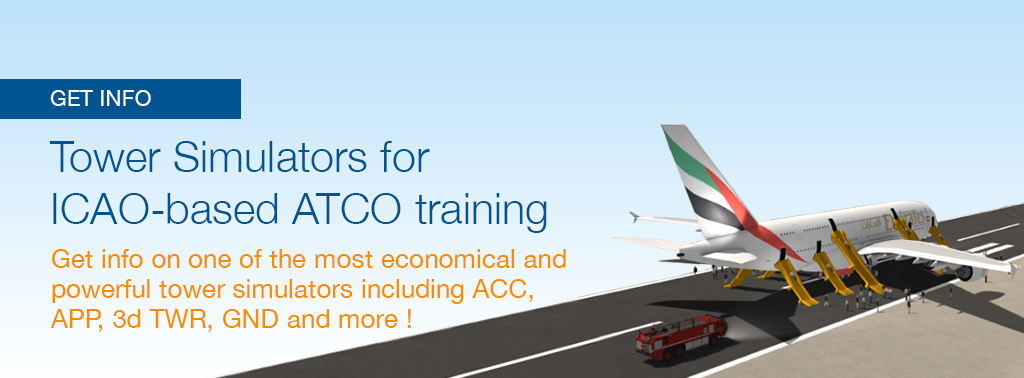Exposure to common and not so common operational situations are a key component of air traffic control training. This is accomplished using highly-advanced simulators that create conditions for not only normal day-to-day operations that air traffic controllers are exposed to but also emergency and failure situations that they might not encounter often in real traffic.
This prepares controllers to handle events that are out of the ordinary scope of day-to-day operations.
One such simulator is an aerodrome simulator that exposes air traffic control students to such simulations. Ideally, simulations such as ACC. APP, TWR, GND and other operations they will encounter in real-life situations as lATCOs should be seamlessly presented on an aerodrome simulator.
Important Simulations Made Possible with the Aerodrome Simulator
Depending on the specialisation chosen by the air traffic control student, he or she will need to be exposed to various situations they will normally encounter on the job. Students will also need to know how to handle situations that are exceptions to the norm, including emergency situations that while they might never experience, they still need to be prepared for.
Understanding Relationships of ACC, APP, TWR, DEP, GND & A-SMGCS
Also known as en route, center or area control, the ACC is the area control center. ACC air traffic controllers issue clearances and instructions to aircraft that is airborne and may also provide ATC services to smaller airports.
- APP stands for approach and only controls approach in a specified airspace. As aircraft approaches an airport, the APP controller is responsible for lining them up for landing. When this is complete, responsibility is passed over to the TWR.
- The next step up from APP-controlles is a CTR (center) controller that covers a larger area of airspace.
- The TWR is the air traffic control tower. The TWR controller normally works in just one airport. When a TWR position is not manned, it could be taken over by an APP controller.
- In the TWR a Clearance Director picks up control from the TWR and provides departure clearance and initial taxi clearance with DEP, which is normally grouped in APP. DEL handles the separation of aircraft for climb and airways.
- Ground controllers (GND) will control most taxiways and may also sequence departures for busier airports to maintain maximum. A GND controller does not oversee active runways. On departures, a GND controller may instruct a pilot to switch communications to the TWR as he approaches the end of the runway.
- The GND controller must be in continual contact with the TWR controller to get approval before clearing aircraft or vehicles to cross or enter an active runway. A GND controller must notify the TWR controller when crossings are complete. They must also notify the TWR controller when departing aircrafts have been taxied to other runways than the one previously designated and when aircraft is ready for takeoff.
- Advanced Surface Movement Guidance and Control System (A-SMGCS) is a 4-level surveillance infrastructure system at airports that consists of cooperative surveillance (multilateration systems) and non-cooperative surveillance (SMR, microwave sensors and/or optical sensors). Eurocontrol’s Airport Operations and Environment division in Belgium has currently validated levels 1 and 2. Under ICAO, the A-SMGCS is used by GND to provide routing, guidance and surveillance to control aircraft and other vehicles to maintain the airport’s surface movement rate in relation to all weather conditions in the aerodrome visibility operational level to maintain the required level of safety.
What Does a Suitable ATCO Training Environment Need?
Training for TWR and GND are typically done with 3D tower simulators and a replica of the ATC control center. Ideally, the simulations are seamless to allow ATCO students the opportunity to learn all procedures and handshake procedures.Depending on the configuration, it would be preferable for a training solution to include working positions for:
-
TWR
-
GND
-
APP
-
ACC
-
Supervisor
-
Pseudo-pilots (individuals, often real pilots who would control arriving virtual aircraft and communicate with the controller trainees)
The training solution should also include a simulation of the TWR and GND area and digital maps of the included airspaces (databases and videomap-set). Additionally, databases of aerodromes, aircrafts (including their performance parameters) and the flight strips (ideally electronic and printable) should also be included in the training solution.This training system should include a:
-
Voice Control System like in a real tower, ideally recordable to replay and discuss exercises
-
Time reference system
-
Flight data processing system FDPS
To respond to ICAO requirements, the front end should be adaptable to the real-life environment, to make it as realistic as possible. An ideal solution would be to use a real operational environment and just feed-in simulated data. Thus, all standards (like the ASTERIX message communication standard would be complied to).




